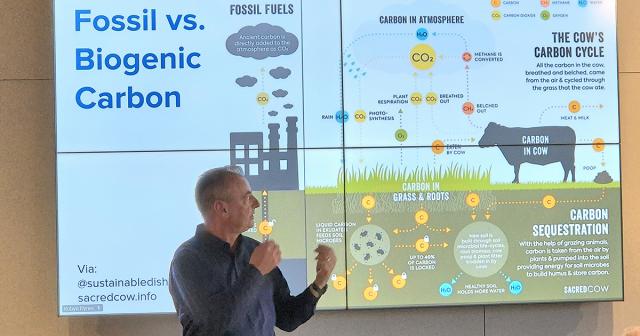World-renowned methane expert Dr Frank Mitloehner visited New Zealand on his way to Australia, where he is being hosted by Cattle Australia. During his visit, he shared the value he sees in working with farmers to reduce agricultural emissions. He advocates for a ‘carrot’ rather than ‘club’ approach and supports managing methane emissions to best control warming.

Dr Mitloehner spoke at a seminar hosted by Beef + Lamb New Zealand (B+LNZ) and AgResearch at Lincoln University which was open to farmers. During his visit, he also met with MPs, officials, scientists, rural professionals, and farmers, discussing both the science of methane and the importance of supporting New Zealand’s efficient food production systems.
As Director of the CLEAR Center at the University of California, Davis, Mitloehner emphasised that methane should be treated differently from carbon dioxide, that includes using the best metrics that we have to accurately measure the warming impacts of our emissions such as GWP*. “Managing methane emissions is important for limiting additional warming,” he said. “Countries like New Zealand, with efficient farming systems already in place, have a significant opportunity to lead the way in climate-smart food production.”
He pointed to California’s experience, where the state has successfully reduced methane emissions from dairy manure by offering grants to farmers to install biodigesters. These systems not only capture methane but also convert it into biofuel, generating carbon credits. “In California, farmers, scientists, and innovators worked together to find what worked best,” he said. “The solutions weren’t imposed – they were developed in partnership.”
While this model isn't directly translatable to New Zealand’s pasture-based system, Mitloehner emphasised that the principle of incentivising farmers through technology adoption and support is universally effective. He advocated for policies that focus on encouraging farmers to implement emission-reduction technologies, rather than using pricing or regulatory penalties.
Mitloehner also discussed the current state of technologies under development globally to reduce agricultural emissions, noting that some may be applicable to New Zealand’s grass-based systems.
Mitloehner’s message aligns with B+LNZ’s position that methane should be accurately measured, that our domestic methane targets are too high and should be amended in line with the principle of no additional warming, and there is no need for a price on agricultural emissions. We also do not want to see any more productive sheep and beef farms converted into forestry.
B+LNZ Climate Change Programme Manager Madeline Hall says GDP100 is not an accurate measure of the true value of warming. “New Zealand farmers produce high-quality, low-emissions food that supports rural communities and generates vital export income,” she said. “Good climate policy should protect and build on these strengths.”
The Lincoln seminar was recorded and will be publicly released to support ongoing conversations about how New Zealand can reduce methane emissions in a practical, scientifically sound, and farmer-led way.
Note: California has a target to reduce methane emissions from dairy manure by 40% by 2030 from a 2013 baseline. Methane emissions from manure represents about half of California’s dairy methane emissions. There is no emissions reduction target for cattle or sheep methane emissions or for dairy emissions from enteric methane (which are the main source of methane emissions in the NZ context). Reductions in enteric methane, such as from using feed inhibitors, can be counted towards the 40% manure target.
Watch a recording of the presentation below.